Temple Square
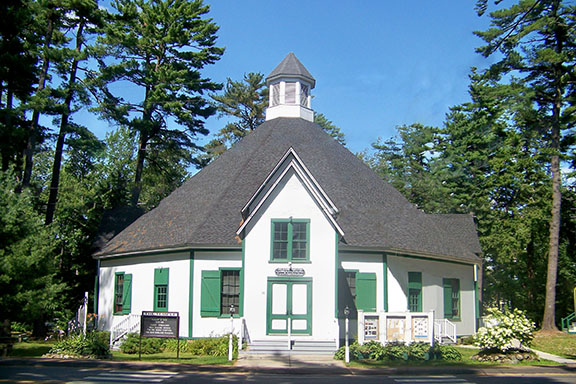
Assembly activities center on the Temple Square, the geographic center of Ocean Park and the historic name for the plot of land on which the Temple, Porter Hall, Jordan Hall and the Bell Tower all stand. The buildings date from the late 19th and early 20th centuries. The Temple was named to the National Register of Historic Places, the nation’s official list of historic places important to our history and worthy of preservation, on April 28, 1975 and on March 2, 1982. The other buildings were added to form a historic district called the “Ocean Park Historic Buildings.”
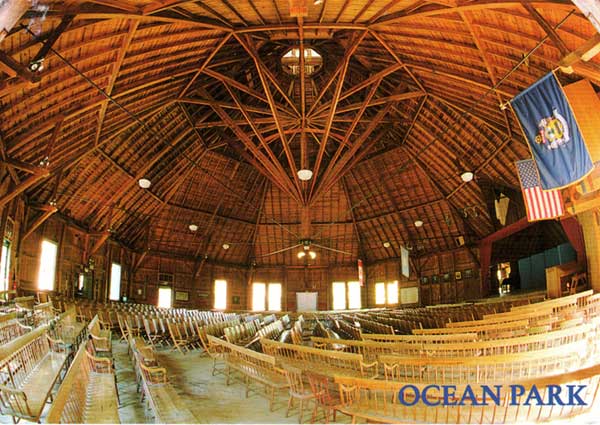 The Temple is Ocean Park’s oldest historical treasure. Sunday morning worship services are held here at 10:30 am throughout the season. It is also the site of most cultural events. The Temple is open weekday mornings for meditation and observation. A special flyer about the history of this unique structure is available in the Temple. View a Panoramic view of interior by Seth Thompson “Sacred Spaces of New England”.
The Temple is Ocean Park’s oldest historical treasure. Sunday morning worship services are held here at 10:30 am throughout the season. It is also the site of most cultural events. The Temple is open weekday mornings for meditation and observation. A special flyer about the history of this unique structure is available in the Temple. View a Panoramic view of interior by Seth Thompson “Sacred Spaces of New England”.
Architectural Notes: This historical building was built in 1881. It is a wooden, octagonal building, 80 feet in diameter, that seats up to 750 people.
Temple Carillon in Ocean Park
Back in 1960, or so, when Stewart Shuster succeeded Don Mason as Music Director and Choir Master, he continued the decades long tradition of playing a hymn, or two, on the Temple Chimes at noontime. By the mid-60s, the chimes became inoperable and there was no money, or interest, to replace them. By visiting other chautauquas in the 80s, 90s, 00s, 10s, and to this day, it was discovered by Ocean Parkers that many chautauquas had carillons that played daily. As a tribute to Stewart when he retired, funds were raised to have a modern, computer generated, carillon that has over 400 hymns programmed into it. That is what one hears today at 5 pm when randomly computer chosen hymns are played. At noontime, there is a pealing of 12 rings to signify the time. The following chautauquas have carillons that also do the same thing everyday of the year: Chautauqua, NY; Lakeside, OH; Monteagle, TN; Bay View, MI; Mt. Gretna, PA; Ocean Grove, NJ.
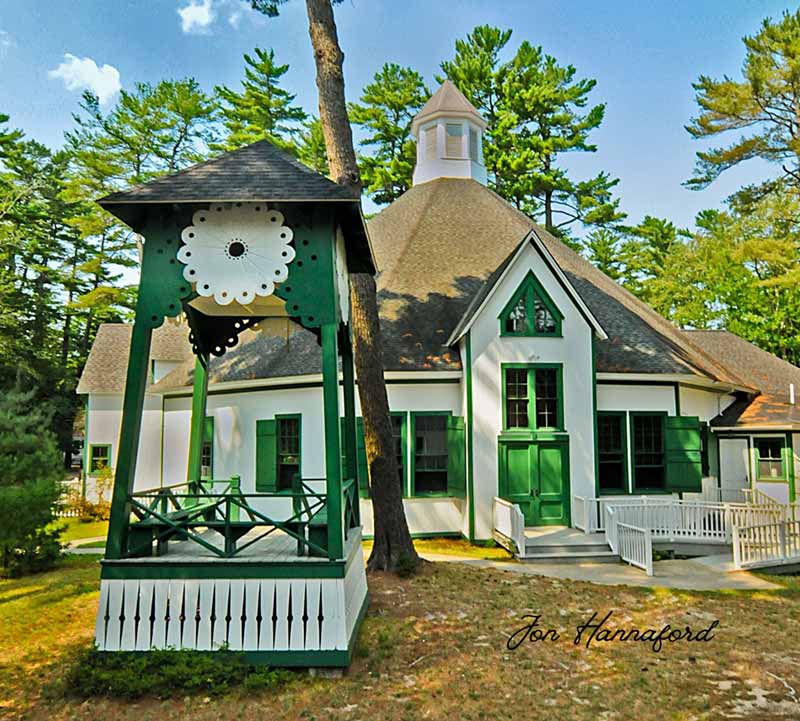 The Bell Tower is used to ring out the start of the Sunday Morning Services, it is a gathering place and also rings out favorite hymns and songs daily. The bell tower is lit at night year-round as a beacon of welcome.
The Bell Tower is used to ring out the start of the Sunday Morning Services, it is a gathering place and also rings out favorite hymns and songs daily. The bell tower is lit at night year-round as a beacon of welcome.
Architectural Notes: The Bell Tower was built in 1882 and consists of a wooden structure, square in plan with hip roof and ornate decoration on each side below the roof evoking a clock face. Access to the deck is by wooden steps from the west. The deck is fitted with wooden railings.
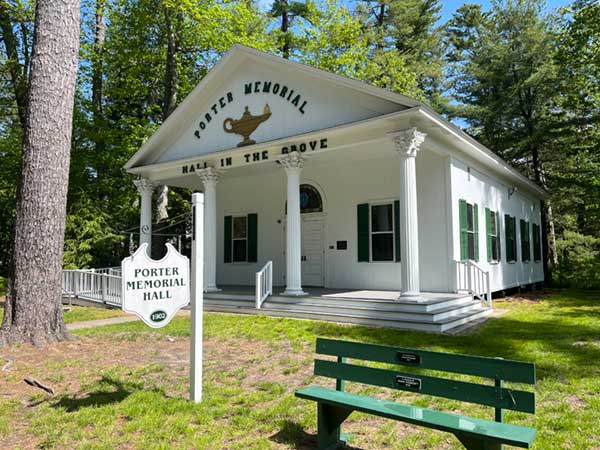 Porter Memorial Hall was dedicated on August 4, 1902. It was built to replace one of the meeting tents known as “The Tabernacle.”
Porter Memorial Hall was dedicated on August 4, 1902. It was built to replace one of the meeting tents known as “The Tabernacle.”
Architectural Notes: Porter Hall is a handsome temple-form building in the neo-Greek revival style, with facade colonnade, gable roof, and match-board siding. The columns are fluted Corinthian and support a pediment that contains the words “Hall in the Grove.” A central entrance of double paneled doors is flanked on either side by a 1/1 window with louvered shutters. The sides of the hall are five bays long, with fenestration as on the facade. An internal brick chimney straddles the roof ridge in the rear.
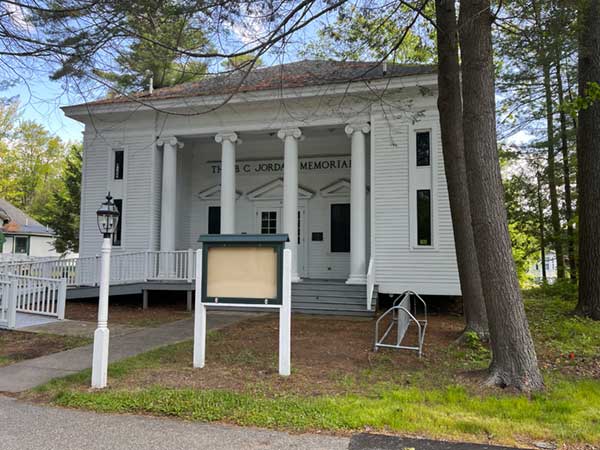
B. C. Jordan Memorial Hall was dedicated on July 19, 1915 and today, it is used for meetings, concerts, and dramatic presentations;
Architectural Notes: This imposing building is of frame construction with two stories, hip roof, and clapboard siding. The five-bayed facade features a four-column colonnade in the Ionic order, behind which is a three-bay recess with double-doored entrance flanked by 6/6 windows. The sides of the hall are seven bays wide. All first story fenestration as on the facade, is 6/6 with pediments, except as noted below. Pediments likewise crown the hall’s doorways. A secondary entrance faces the west. While the facade contains only one story, the sides and rear are two stories high. Second-floor fenestration consists of small rectangular casements, except at the rear where all bays are 6/6. Tall rectangular windows comprise the extreme bays on the facade and sides of the hall.
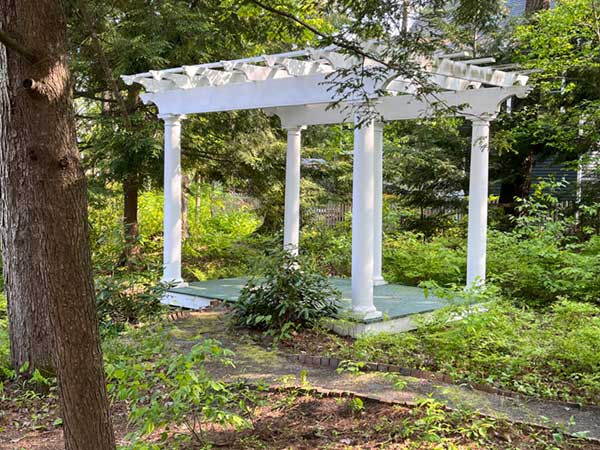
Temple Garden and Pergola
Across the street from the Temple is the Temple Garden with the Pergola, a garden arbor, and labyrinth (a meditative pathway leading to the Pergola). Originally built in 1921 and restored in 2007, the Pergola is a place for restful contemplation.
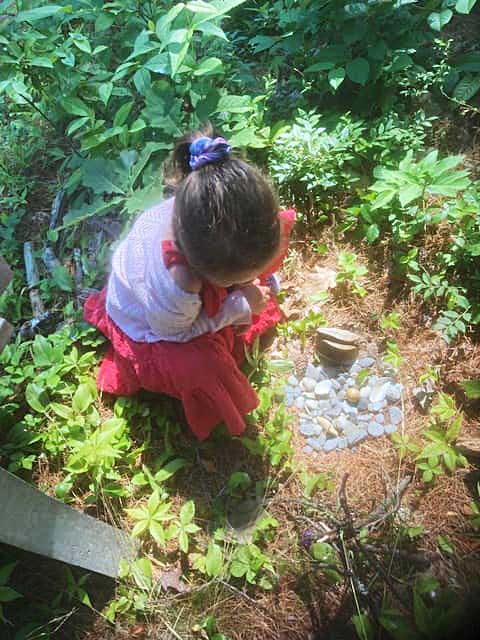
Fairy Garden
The Fairy Garden is located across from Jordan Hall on Temple Avenue. It consists of miniature houses for the fairies, built of all natural materials. The garden is open to builders and visitors all summer. Wear your fairy wings and build a one-of-a-kind fairy house!